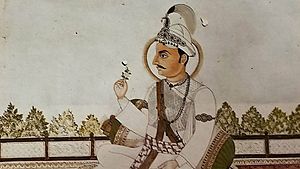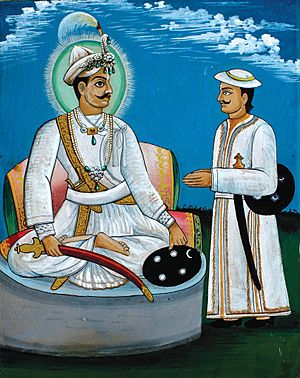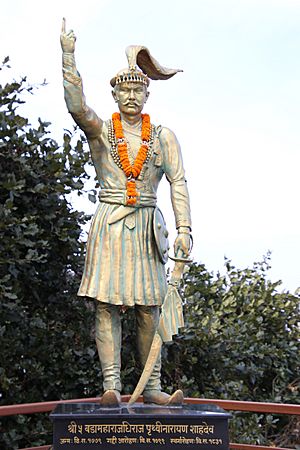Prithvi Narayan Shah facts for kids
Quick facts for kids Prithvi Narayan Shah |
|||||
|---|---|---|---|---|---|

A modern reproduction of a posthumous miniature of Prithivi Narayan Shah by Garhwali artist Mola Ram c. 19th century.
|
|||||
| King of Gorkha | |||||
| Reign | 3 April 1743 – 25 September 1768 | ||||
| Coronation | 3 April 1743 | ||||
| Predecessor | Nara Bhupal Shah | ||||
| Successor | Position abolished (himself as the King of Nepal) | ||||
| King of Nepal | |||||
| Reign | 25 September 1768 – 11 January 1775 | ||||
| Coronation | 25 September 1768 | ||||
| Predecessor | Position established | ||||
| Successor | Pratap Singh Shah | ||||
| Chief of Nepalese Army | |||||
| Reign | 1743 - 1743 | ||||
| Coronation | 1743 | ||||
| Successor | Shivaram Singh Basnyat | ||||
| Born | 7 January 1723 Gorkha Palace, Gorkha Kingdom (present-day Gorkha District, Nepal) |
||||
| Died | 11 January 1775 (aged 52) Devighat, Kingdom of Nepal |
||||
| Spouse | Indra Kumari Devi Narendra Rajya Lakshmi Devi |
||||
| Issue | Pratap Singh Shah Vedum Shah Bahadur Shah Bilas Kumari Narayan Shah Vishnu Shah |
||||
|
|||||
| Dynasty | Shah | ||||
| Father | Nara Bhupal Shah | ||||
| Mother | Kaushalyavati Devi | ||||
| Religion | Hinduism | ||||
Prithvi Narayan Shah (1723–1775) was a very important leader in Nepal's history. He was the last ruler of the Gorkha Kingdom. He then became the first king of the unified Kingdom of Nepal. People often call him the Father of the Nation in Nepal.
He started the big project of bringing many small states together. This process is known as the unification of Nepal. He called the new unified Nepal Asal Hindustan, which means "Real Land of Hindus." This was because much of North India was ruled by the Islamic Mughal Empire at that time.
Contents
Early life
Prithvi Narayan Shah was born on January 7, 1723. He was the first child of Nara Bhupal Shah and Kaushalyavati Devi. He was born a little early, in Gorkha Palace.
His education started when he was five years old. Teachers called Upadhyayas taught him in the palace. They were also astrologers. Queen Chandra Pravawati also helped shape his character. She made sure he stayed away from bad habits.
From a young age, he was interested in his father's kingdom. He soon started taking on responsibilities. He dreamed of taking over Nuwakot. His father had lost it to the Malla kings of Kathmandu.
In 1743 AD, his father died. Prithvi Narayan Shah became king of Gorkha at age 20. He cared about his people. He often talked to them about their worries. This helped him understand what they needed. He also kept good relationships with his neighbors. But he was careful with the East India Company.
Reign and unification
Before Prithvi Narayan Shah, Nepal had many small states. There were 54 states in total. These included states in the Terai, West, and Karnali regions. The main ones were Gorkha, Mustang, Bhaktapur, Kantipur, and Lalitpur.
When Prithvi Narayan Shah became king in 1743, Gorkha was a small state. He wanted to make it big and strong. He traveled to Varanasi in India. This was a big trade center. He met many people and learned about the politics and society of the region. In Varanasi, his father-in-law helped him get firearms and ammunition.
Taking Nuwakot
Prithvi Narayan Shah first tried to conquer Nuwakot in 1743. But he failed. Taking Nuwakot was very important for unification. It was a key trading route to Tibet.
After returning to Gorkha, he made friends with leaders of nearby states. These included Lamjung, Tanahun, and Palpa. Then, he sent his army to attack Nuwakot from three sides. The king of Nuwakot had gone to ask for help from Jaya Prakash Malla. So, his son led the Nuwakot army. Prithvi Narayan Shah's Gorkha army won in 1744 CE. Nuwakot became part of his kingdom.
Conquering Kirtipur
Prithvi Narayan Shah's next plan was to take over areas around the Kathmandu Valley. This would create economic problems for the valley. This would make it easier to conquer. He first attacked Kirtipur, a strong town near Patan. He was defeated in 1757. His minister, Kalu Pande, was killed. This was a big loss for the Gorkhas. They could not try again until 1763.
In 1765, Prithvi Narayan Shah attacked Kirtipur a third time. This time, he won. The fierce way the Gorkhas fought scared the nearby people. This made it easier to conquer other areas.
Makwanpur and Chaukot
In 1763, the Gorkhas took over Makwanpur. This was an important entry point to Nepal from Bengal. This led to a conflict with Mir Qasim, the ruler of Bengal. The king of Makwanpur was captured. A local chief asked Mir Qasim for help. Mir Qasim sent his army, but they were defeated by the Gorkhas.
The Gorkhalis also fought for six months with the people of Dhulikhel. Prithvi Narayan Shah built a fort near Chaukot. He gathered many soldiers there. After a tough battle, the Gorkhalis won. They lost many men, but they took Chaukot. Prithvi Narayan Shah admired the bravery of the enemy leader, Mahindra Sinha Rai. He made sure Mahindra Sinha's family was protected. After this, he easily took five more villages.
Kathmandu Valley
Next, he wanted to take the Kathmandu Valley. It was easier because the Nepali rulers were fighting among themselves. Ranjit Malla, the ruler of Bhadgaon, asked Prithvi Narayan Shah for help. He was fighting with the rulers of Patan and Kathmandu.
Prithvi Narayan Shah took Bhadgaon. Then, he surrounded Patan in 1767. The Gorkha power grew quickly around the valley. Jaya Prakash Malla, the ruler of Kathmandu, was trapped. His city faced starvation. The valley was completely cut off from the outside world.
Jaya Prakash Malla asked the Bengal Presidency for military help. The East India Company saw this as a chance to gain influence. They sent a warning to Prithvi Narayan Shah. They also decided to send an army to help Jaya Prakash.
When Prithvi Narayan Shah entered Bhadgaon, he saw the three kings sitting together. He and his men laughed. Jaya Prakash Malla was upset. Prithvi Narayan Shah respected Ranjit Malla. He asked him to continue ruling. But Ranjit Malla wanted to go to Benaras. Shah allowed him to leave.
Prithvi Narayan Shah also took control of the Kuti Pass around 1756 CE. This stopped all trade and communication with Tibet.
Kinloch expedition
Jaya Prakash Malla desperately asked the East India Company for help. He sent messengers to them. The Company thought helping him would open trade with China through Nepal. They decided to send a military force.
Prithvi Narayan Shah knew about this danger. He sent a letter to the Company. But the Company decided to send help to Jaya Prakash Malla anyway. George Kinloch was chosen to lead the expedition.
In June 1767, Kinloch learned about Prithvi Narayan Shah's army. He was told that Shah had about 50,000 soldiers. The messengers also said that there was no time to lose. The monsoon season would make travel in the hills very difficult. They also said that Shah had taken ten main cities. He had blocked Kathmandu, Patan, and Bhadgaon.
However, the expedition failed. The main reasons were that their supplies were destroyed by a sudden flood. Also, the promised help with food from the Nepali rulers did not come. The soldiers faced starvation and sickness. They tried to cross the Bagmati River, but the strong current washed away their bridge. The troops had to retreat. Prithvi Narayan Shah's Gorkhas chased them. Kinloch's failure allowed Prithvi Narayan Shah to conquer the remaining cities. By the end of 1768, he had taken all the cities. He reportedly entered Kathmandu during the Indra Jatra festival.
Divyopadesh
Towards the end of his life, Prithvi Narayan Shah was very sick. He felt his end was near. So, he held a special meeting called bhardaari-sabha. In this meeting, he talked to his family and ministers. He explained why he unified Nepal. He also shared his ideas for Nepal's future policies. This meeting lasted for about 5-6 hours. His brothers and ministers wrote down his messages. These writings became known as Divyopadesh.
मेरा साना दुखले आर्ज्याको मुलुक होइन यो चार बर्ण छात्तिश जात सबैको साझा फूलबारी हो सबैलाइ चेतना भया । (transl. This is not the nation gained by my small efforts. This is a common garden for all four main castes and 36 sub-castes. May everyone be aware of this.)
Foreign policy
Prithvi Narayan Shah saw Nepal as a "Yam between two boulders." He meant China to the North and the "Emperor of Seas" (British) to the South. He said Nepal should always be good friends with China.
He also had a clear policy for the East India Company. He suggested being friendly but also very careful. He believed the Company was taking over India by force. He warned that if Indians woke up, they might seek safety in Nepal. So, he told his soldiers to be ready. He wanted them to build forts in important places.
Economic policy
Prithvi Narayan Shah strongly believed in making things locally. In his Divya Upadesh, he said that foreign traders would drain Nepal's wealth. He suggested not wearing foreign clothes. He also wanted local people to be trained to weave clothes. He thought this would keep wealth inside the country.
He encouraged selling Nepali herbs to other countries. This would bring money back to Nepal. He famously said, "प्रजा मोटो भए दरबार पनि बलियो रहन्छ" (If the people are capable, then the palace will also remain stronger). This meant that a strong economy for the people makes the country strong.
Defense policy
King Prithvi Narayan Shah created the Nepal Army in August 1762. He named some of its first companies: Shreenath, Kali Baksh, Barda Bahadur, and Sabuj.
He thought Nepal was a natural fort made by God. He stressed the importance of building strong forts. He suggested building one strong fort each on Shivapuri, Phulchowki, Chandragiri, Mahadevpokhari, Palung, Daapcha, and Kaahule. He wanted cannons placed in each of them, ready to fire. He also wanted iron doors at mountain passes (bhanjyangs). He believed this would keep the country safe from spies and invaders.
Memorials
Many things have been built or named to remember King Prithvi Narayan Shah. These include:
- Prithvi Highway
- Prithvi Rajpath
- Prithvi Statue (Singh Durbar)
- Prithvi Statue (Pashupatinath temple)
- Prithvi Memorial statue, Chandragiri
- Maharaja Prithvi Narayan Shah Memorial Foundation
- Prithvi Narayan Shah's Statue, Rastra Bibhuti Park, Pokhara
- Greater Nepal: Quest for Boundaries (Documentary)
- Prithvi Narayan Campus , Pokhara
- Prithvi Museum
- Prithvi Narayan Shah Statue, Sindhuli Gadi Fort
Death and legacy
King Prithvi Narayan Shah successfully brought many small states together. He added them to his kingdom. This expansion was very important for Nepal's survival. The East India Company was growing fast in India. Shah believed that if Nepal remained many small states, it would be easily conquered. By expanding his kingdom, he made sure Nepal stayed independent. This allowed Nepal to deal with foreign powers as an equal.
In January 1775, Prithvi Narayan Shah died at Devighat, Nuwakot. He was 52 years old. His son, Pratap Singh Shah, became king after him. His younger son, Bahadur Shah, continued his work of unifying Nepal.
Images for kids
See also
 In Spanish: Prithvi Narayan de Nepal para niños
In Spanish: Prithvi Narayan de Nepal para niños












